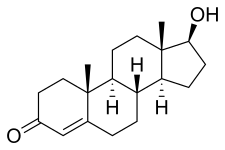Androgens
| Androgen | |
|---|---|
| Drug class | |

Testosterone, the major androgen in humans and a widely used medication.
|
|
| Class identifiers | |
| Use | Hypogonadism, transgender men, performance enhancement, bodybuilding, others |
| ATC code | G03B |
| Biological target | Androgen receptor, mARs (e.g., GPRC6A, others) |
| External links | |
| MeSH | D000728 |
Androgen (from Greek andro meaning male human being), also called androgenic hormone or testoid, is any natural or synthetic compound, usually a steroid hormone, that stimulates or controls the development and maintenance of male characteristics in vertebrates by binding to androgen receptors. This includes the activity of the primary male sex organs and development of male secondary sex characteristics. Androgens were first discovered in 1936. Androgens increase in both boys and girls during puberty. Androgens are also the original anabolic steroids and the precursor of all estrogens. The primary and most well-known androgen is testosterone.Dihydrotestosterone (DHT) and androstenedione are less known generally, but are of equal importance in male development. DHT in the embryo life causes differentiation of penis, scrotum and prostate. Later in life DHT contributes to balding, prostate growth and sebaceous gland activity. Although androgens are described as male sex hormones, both males and females have them to varying degrees, as is also true of estrogens. They are one of three types of sex hormones, the others being estrogens like estradiol and progestogens like progesterone.
The main subset of androgens, known as adrenal androgens, is composed of 19-carbon steroids synthesized in the zona reticularis, the innermost layer of the adrenal cortex. Adrenal androgens function as weak steroids (though some are precursors), and the subset includes dehydroepiandrosterone (DHEA), dehydroepiandrosterone sulfate (DHEA-S), and androstenedione.
...
Wikipedia
